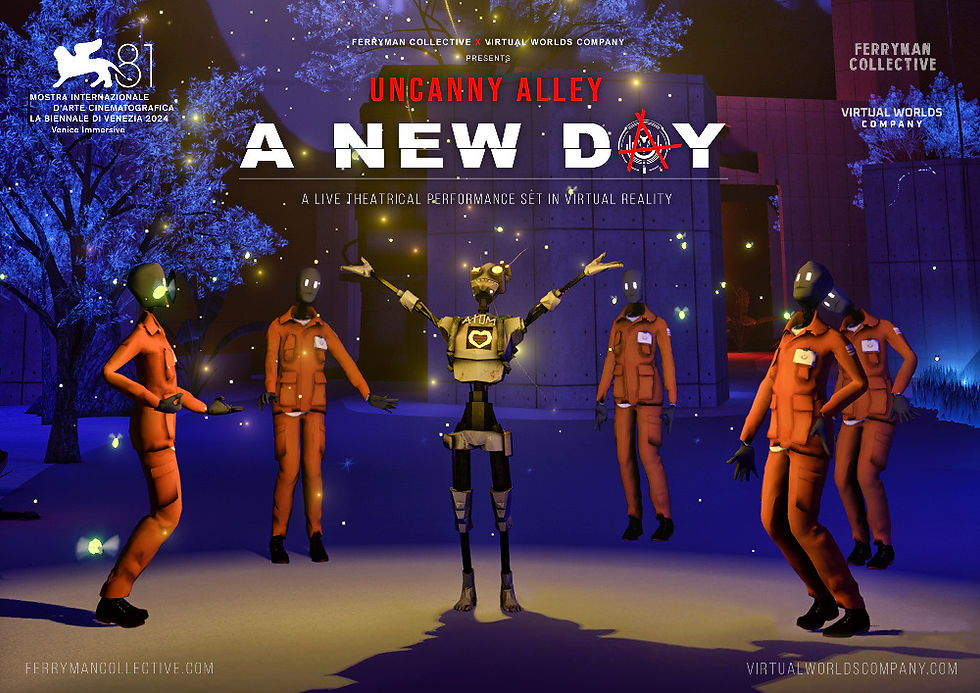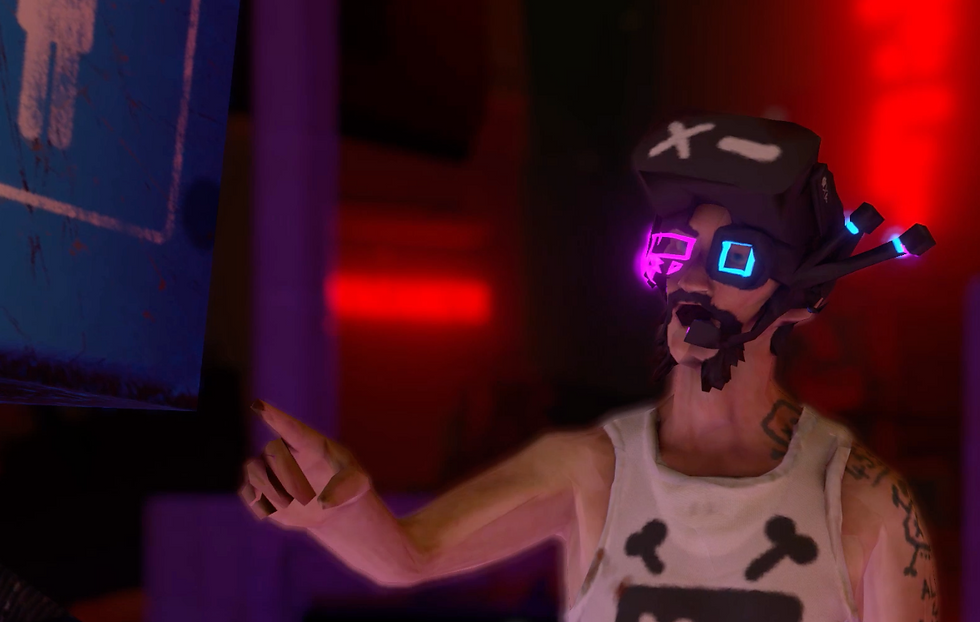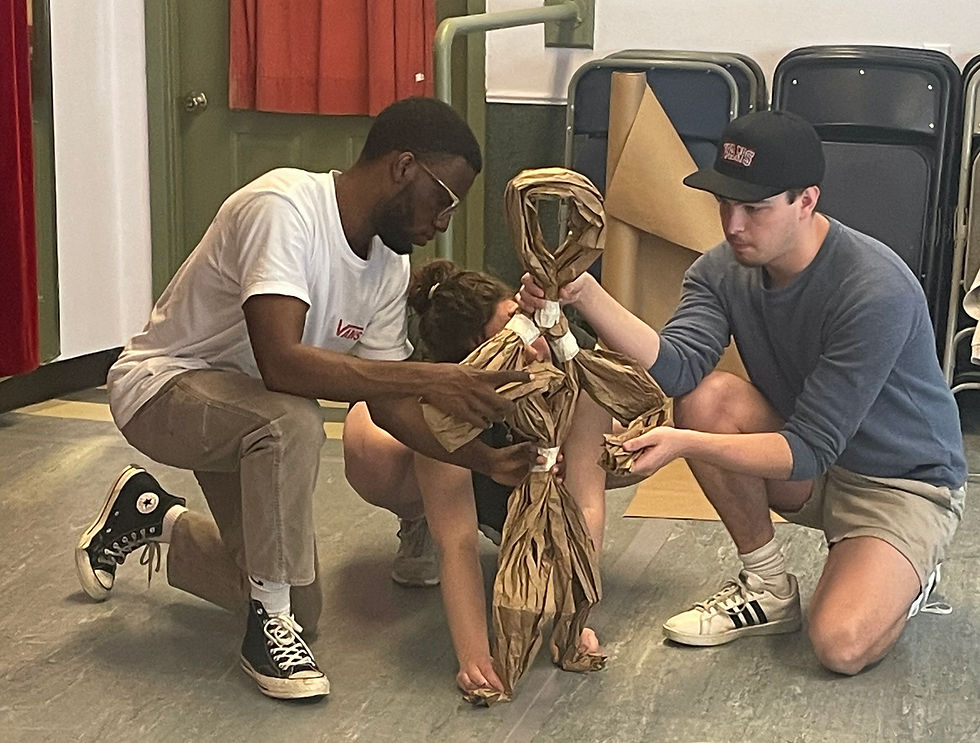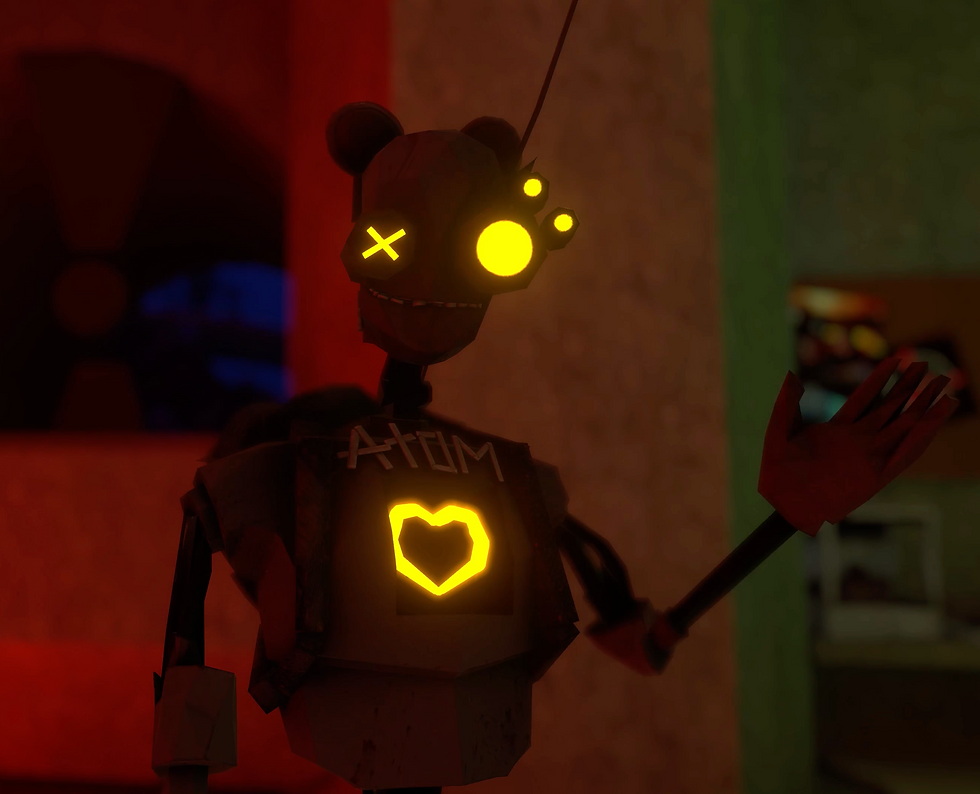Gods, Tigers, and Avatars: What Puppeteering Can Teach Us About Creating Great VR Experiences
- anatolyjm
- Sep 1, 2024
- 10 min read
A growl freezes everyone in earshot. From the gloom of a darkened doorway, heavy steps and heavy breath become a large Royal Bengal tiger as it steps into the feeding cage.

LIFE OF PI. Photo: Matthew Murphy and Evan Zimmerman.
It pauses, it sniffs the air, ears swiveling, listening. The goat at the other end of the feeding cage twitches with fear. The tiger’s head turns and its eyes lock onto the now trembling goat. The tiger pauses for a split-second, then slowly lowers into a crouch, preparing to pounce on its prey.
So goes the series of physical actions and events leading up to the moment when the Bengal tiger, Richard Parker, first enters the stage in the Broadway and West End productions of Life of Pi. It’s a thrilling moment of physical stagecraft, one that takes all of 90 seconds to play out. In that minute and a half, Richard Parker is established as a creature of primal power and grace. The audience not only can see his mass and muscle, see the breath in his massive rib cage, but they swear they can feel his hot breath and the crunch of bone as he bites down on the goat.

LIFE OF PI. Photo: Matthew Murphy and Evan Zimmerman. Shown: Rowan MaGee and Celia Rubin.
Of course, neither Richard Parker, nor the poor goat, are actual flesh and blood animals, they are exquisitely designed and operated puppets.
Through a combination of careful design and engineering of the physical puppets, the support of sound and lights, and most importantly, the performances of the actors and puppeteers onstage, this moment grips the audience’s attention in ways at once terrifying, delightful, tragic, and awe-inspiring. As part of the team of puppeteers who brought Richard Parker and the other puppets in Life of Pi to the stage, we spent countless hours preparing this first entrance so that the hairs would raise on the back of the audience’s neck.
How exactly is a thrilling event like this crafted? This question is central to my current research in immersive media, which applies narrative and experience design principles from a range of art forms and applies them to emerging technology. In this article we’ll look at what puppetry techniques can teach us about creating emotionally deep and meaningful moments in digitally rendered performances.
DIGITAL PUPPETRY
This week, Ferryman Collective and Virtual Worlds Company’s “Uncanny Alley: A New Day,” a live theatrical performance in virtual reality, premieres at the Venice International Film Festival VR. This marks my fifth time performing in virtual reality (VR) at the festival, making it a fitting moment to examine how puppeteering has informed my work in VR and how puppetry principles can be used by VR content creators, animators, and performers.

Artistic Direction by Rick Treweek; Theatrical Direction by Stephen Butchko; Produced by Deirdre V. Lyons.
Most performances in VR are crafted via digital avatars. Sometimes these avatars are brought to life in real time by performers, as in “Uncanny Alley,” while in most VR experiences they are animated in advance by a performer via a motion capture system or by an animator. In all of these cases, I would make the argument that the end result is, for all intents and purposes, a kind of puppetry. And if we’re manipulating puppets in our virtual plays, games, training experiences, and corporate onboarding tutorials, we better know what makes an audience captivated by them.
Humans are keenly tuned into the micro-movements of other humans. Most of us are able to quickly and precisely identify the internal states and changes of thought of another human without that person making an effort to show them. But puppets and avatars don’t move or communicate emotion, movement, and thoughts in the same way or with the same high degree of subtlety; some technique is necessary to help the audience follow the thoughts and intentions of puppets and avatars.
So let’s dive into 6 principles of puppetry that, I think, every animator, director, and performer working in VR and other 3D digital mediums should know.
1. Breath

LIFE OF PI. Photo by Chris Tuttle. Shown: Jonathan David Martin (puppeteer), Rajesh Bose (background).
Thinking about breath when talking about puppets or digital avatars may seem a bit counterintuitive, and that’s exactly why it’s so essential that we start with breath when crafting a performance with either of them. As a puppeteer, my breath becomes the puppet’s breath. Watching a puppet simply breathe onstage can be captivating, it’s what creates the illusion of life in a puppet, and thus why we care about what they do, what they think, and what they feel. The same is true with animated and/or digital characters — watch any good 2D animated film and you’ll also see this in action. However, unlike in a 2D film, where the director and editor can manipulate the audience’s attention with cuts and closeups within the frame of a screen, in VR, as in a puppetry performance, it’s all on the performance to hold the audience’s attention. Actively using breath is key to doing so.

Photo by Paul Kolnik. Shown: Prentice Onayemi, Jonathan David Martin, Jeslyn Kelly (puppeteers) with Peter Hermann (standing) and Elliot Villar.
One of the first exercises I encountered in my puppetry training, while working on the Broadway production of War Horse, was to take a stick and to figure out how you would show its breath if it came alive. Did it move up and down with each breath? Were there little twigs that could be swung in and out? What was the quality of the breath — fast, slow, light, belabored? Just making choices about the breath starts to communicate a lot about the character’s thoughts and emotional state.
Often, characters in VR — again both pre-recorded and performed live — have no visible sense of breath. Neither the avatar designer nor the animator or performer has included this in the performance. As a result, the audience never gets a visceral sense of the character’s state of being or changes in thought and action. When I work with a new avatar, I will often explore how I can visually communicate breath, at least in moments of heightened emotion or when dramatic changes of thought and intention occur. This might be through a subtle shift of the head or by pairing gestures with breath.
Along with making the breath visible, the school of puppetry that I learned emphasizes making the breath audible as well. Making the breath audible can often be an effective substitute or addition to seeing the movement of breath within the avatar.
2. Focus (Eyeline)

A scene from “Uncanny Alley.” Avatar by Rick Treweek.
Nowhere is the adage “the eyes are the windows to the soul” more true than in puppetry. In tandem with the breath, a puppet’s eyeline speaks volumes about what it’s thinking and to what it’s paying attention. For both puppets and avatars, what they are looking at, how they long they look at it, or how they scan a space or look at various points of focus, brings us inside of their minds. When eyeline gets lost, so do the thoughts. When the focus clearly changes from one point to another, we follow the puppet/avatar’s change of thought.
Humans are hardwired to be keen observers of eyeline and the difference between looking directly at the object of the character’s attention and just off of it, is notable. This is especially true in live VR performances like “Uncanny Alley” where the performer’s avatar interacts directly with the audience member’s avatar. In these moments, you can feel when eye contact is made and when it occurs a visceral connection can be made.
3. Body

LIFE OF PI. Photo: Matthew Murphy and Evan Zimmerman. Shown: Hiran Abeysekera with Fred Davis, Scarlett Wilderink, and Andrew Wilson (puppeteers).
Body concerns the character’s physical makeup. It’s their muscle and bones, their mass. The tiger, Richard Parker, is a 500lb bruiser made of tightly coiled muscle, solid bones, and sharp claws. The paws are thick and meaty while the tail is lithe and light. The head is like a wrecking ball with teeth. Fortunately for us as the puppeteers, the puppet’s construction is quite a bit lighter. But this means that it’s up to us as the puppeteers to imbue the puppet with the body characteristics of a real tiger. We must act — through our breath as well as our movement — as though the character were a half ton cat capable of taking down a buffalo, not a loose collection of wood, bungee, and foam.
The challenge of accurately representing the body for performers and animators of avatars in VR is often higher than those of a puppeteer. For instance, in Double Eye Studios acclaimed production of “Finding Pandora X,” I played the god, Zeus, who grew to 30 feet high when angered. For me as the performer, the avatar felt just the same as an avatar of any other size, so I needed to imagine clearly that my body was no longer the size of a normal person, that it now had tons more mass and power.

“Finding Pandora X,” Directed by Kiira Benzing.
As this example shows, body refers to the performer’s body as well as to the puppet’s or avatar’s. As much as the puppet’s breath is an extension of the puppeteer’s, the puppet’s body is also an extension of the puppeteer’s.
4. Passing the Ball
(Communicating through movement)

Imagine you are watching a tennis match. Better yet, imagine that you are watching the crowd watch a tennis match. What do you see? A sea of heads pivoting back and forth, following a small green ball as the players smack it back and forth to each other. The players’ eyeline and body are solely focused on the ball, and the intensity of their concentration amplifies the crowd’s.
Onstage or in a virtual reality experience, we can imagine that there is a ball representing the audience’s point of attention. As puppeteers, we need to spend as much mental and physical energy as tennis players to keep the ball of attention moving clearly from one moment to the next. How do we do this? Well, it often means creating gestures and other movements with clear beginnings, middles, and endings. It means using eyeline to throw focus to another point in space — i.e. another character — when we want to pass the ball of the audience’s attention elsewhere. It means communicating with the puppet’s body and voice when the audience should pay attention to it and to then send that attention clearly off to another point.

A scene from “Uncanny Alley.” Avatars by Rick Treweek.
When a puppet or an avatar fails to pass the ball clearly — i.e. by moving in ways that are hard for the audience to follow — the audience’s attention drops and they lose the thread of the narrative.
Again, puppets and avatars are almost always novel characters for an audience to follow physically. They don’t express themselves exactly the way a human being does and so the puppeteer or animator should be wary of treating their movement as casually as they would a human’s.
5. Stillness

LIFE OF PI. Photo: Matthew Murphy and Evan Zimmerman. Shown: Rowan Magee and Celia Rubin (puppeteers) with Adi Dixit.
The temptation as a puppeteer is often to show the audience how well you can manipulate the puppet and to keep their attention by being in constant action. Similarly, in virtual performances — again whether crafted live or prerecorded — it’s easy to believe that you must constantly provide action, dialogue, and movement to keep the audience’s focus. Looking for moments of stillness can therefore feel counterintuitive and uncomfortable.
But stillness can create a powerful state of suspense or intimacy or vulnerability (this, of course, is true for any kind of performance whether actor or puppet, 2D or 3D). The key for puppets and avatars is that stillness must be found with an active breath that keeps the internal life of the character alive. (Indeed, the primary difference between acting and puppeteering is that puppeteers have to work hard to make their characters come to life, while actors have to work hard to play dead.)

Students from Lipscomb University practice finding a moment of stillness and breath in a puppetry workshop.
Stillness doesn’t have to be long, often it is the briefest of pauses between one thought and action to the next. This tiny hiatus allows the audience to follow each move, to see where one thought ends and a new one begins, and as a result empathize more fully with the character.
In an immersive experience like in VR, the director may need to think about how to train and reward the audience early on to tune in to stillness. Otherwise stillness might feel empty and a moment full of dramatic tension may be missed by an audience running around looking for the next plot point or interaction. This is where the design elements, in particular lighting and sound, are so essential in crafting the audience’s attention along with the performances.
6. Imagination

LIFE OF PI. Photo: Matthew Murphy and Evan Zimmerman. Shown: Rowan Magee, Celia Rubin, Nikki Calonge (puppeteers) with Adi Dixit.
Imagination, like all of the principles that we’ve covered, is an essential ingredient to any dramatic performance but I would argue that the puppeteer’s imagination is exercised slightly differently than the actor’s. The puppeteer (and I think the animator as well) has to not just put themselves in the imaginary circumstances of the performance but they have to imagine themselves in another body entirely. This body, like Richard Parker’s, might not be human, or like the example of Zeus, it might be a body that is distinct from their body in a particular way. The puppet or avatar’s body does not move or express itself the same way we do in our own bodies. The eyes may not blink, the fingers may not all be fully articulated, the spine may not bend, one limb might be bigger than the other, etc. It’s the performer and animator’s job to embody these figures on their own terms, using the puppet or the avatar’s particular affordances or limitations to their utmost.

A scene from “Uncanny Alley.” Avatar by Rick Treweek.
In “Uncanny Alley,” the audience encounters an incredible cast of characters, some of whom are human and some that are not. With each character, I’m constantly exploring how it communicates its wants and desires most effectively to the audience.
If I’ve done my preparation well, I’m not thinking about any of these principles in the performance, but especially when I’m learning a new role and show, they are helpful principles to come back to in order to find greater depth and life.
When I work as a director in VR, I also keep these principles in mind. They help me create a shared vocabulary with my performers and animators and they can be particularly helpful for troubleshooting moments where the audience’s attention gets lost or the level of their investment seems to wain.
FINAL WORD
Whether you’re a performer, an animator, a director, a world builder, or a narrative designer, I hope these principles can be a useful part of your tool belt, as well. For me, they can make the difference between a virtual experience that is just interesting to one that is moving, compelling, and above all, deeply human.

A scene from “Uncanny Alley.” Avatars by Rick Treweek.
If you’re curious to learn more about puppetry or puppeteering, I highly recommend you check out the work of my mentors in the field, from whom the principles above are drawn: Basil Jones,Adrian Kohler, Mervyn Millar, Finn Caldwell, Scarlett Wilderink, and Fred Davis. Basil and Adrian of Handspring Puppet Company designed the puppets for War Horse. Mervyn was the production’s puppetry director. Do check out Mervyn’s excellent book, “Puppetry: How To Do It.” Finn Caldwell was the puppetry director for Life of Pi, Scarlett his associate puppetry director, and Fred the production’s puppetry captain. I owe a huge debt of gratitude to all of these incredible artists and teachers.

Comments